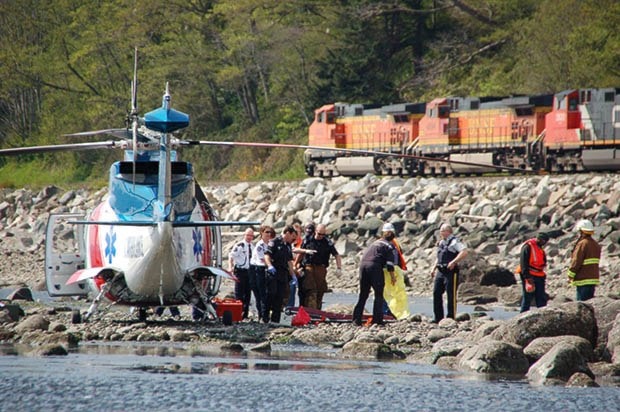SOUTH SURREY/WHITE ROCK — The view from the southwest flank of Canada’s coastline — between Crescent Beach and the city of White Rock — is breathtaking.
“It’s Canada’s Amalfi coast,†enthuses Erik Seiz, president of the Crescent Beach Property Owners Association.
With its towering bluffs, ocean views and expansive beaches, it’s hard to argue. But southern Italy doesn’t have to deal with incessant and increasingly dangerous rail traffic.
Over the past 10 years, industrial train traffic in the Surrey region has seen a 10-fold jump. Close to 20 trains chug through the heart of Crescent Beach and White Rock every day, putting the community, which is bisected by a busy rail line servicing the U.S. market, on edge.
Last July, a White Rock (mortgage broker), out for an evening jog with her husband, was killed after being struck by an Amtrak train near the city’s pier; she was one of 19 people killed by trains along this tiny stretch of track.
The reason for the line’s distressingly high accident rate is its location: the track parallels the seaside, cutting off access to the beach.
So the tens of thousands of kayakers, crabbers, walkers and sun seekers who flock to White Rock’s famed beach every summer day must scramble over the dangerous, beachfront rail line to access it.
Similar problems plague Crescent Beach in nearby Surrey, where rail derailments and decouplings can literally cut the community off from the outside world — even first responders. This happened twice this summer; in June, access to Crescent Beach, one of the province’s busiest beaches, was blocked for almost an hour.
Attempts to address safety concerns at White Rock and Crescent Beach have resulted in much public discontentment. Transport Canada’s orders that all trains entering White Rock blast their horns an ear-shattering 125 times is creating widespread anger. And plans to erect ugly, six-foot fencing along the entire length of the city’s picturesque waterfront promenade have been met with similar outrage.
To maintain safety and restore the integrity of the beachfront at White Rock and Crescent Beach, which are repositioning themselves as tourist hubs, many advocate an alternative approach: moving the problematic rail line inland, away from the densely populated areas and its beautiful beachfronts.
Support for the plan is growing.
Surrey Mayor Dianne Watts and White Rock Mayor Wayne Baldwin are major proponents. Watts notes that rail traffic on the line has jumped by more than 1,000 per cent in the last decade.
And huge amounts of hazardous substances, including chlorine, hydrochloric acid and propane, are now moving along the heavily populated, seaside corridor.
With Surrey’s population set to eclipse Vancouver’s in the next decade, the realignment would reduce the risk for a “catastrophic†derailment, Baldwin adds.
On the industry side, BNSF, the U.S. rail giant, and Amtrak, the U.S. passenger rail carrier — both of whom stand to benefit from faster transit times, with the shorter, more direct proposed route — have expressed interest in realignment, which could cost upwards of $350 million. Proponents envisage a cost-sharing plan, which would include all three levels of government. Benefits, after all, would extend beyond White Rock.
The new line would be a linchpin to B.C.’s Pacific Gateway strategy, which aims to increase Canadian access to Asian markets.
Already 40 per cent of the Lower Mainland’s U.S. trade ships along the rail route. And plans include the creation of a new, divided bike route extending all the way from Vancouver to the Peace Arch border crossing. A proposed waterfront walkway would link to some of the region’s top trails and parks, like birder’s paradise, Blackie Spit and Langley’s Nicomekl River Trail.
To Baldwin, the current line is the “worst possible route†from the U.S. to Vancouver. “It’s longer, it’s slower, it winds, it twists,†and it runs alongside a bank prone to slides. “We’re dealing with people’s lives,†says Baldwin. And that’s the bottom line.
It is imperative that all parties come together to find a solution that is economically beneficial and protects public safety. The sooner this is realized, the better we will all be.
— Mary-Jane Bennett is a Research Fellow at the Frontier Centre for Public Policy.
